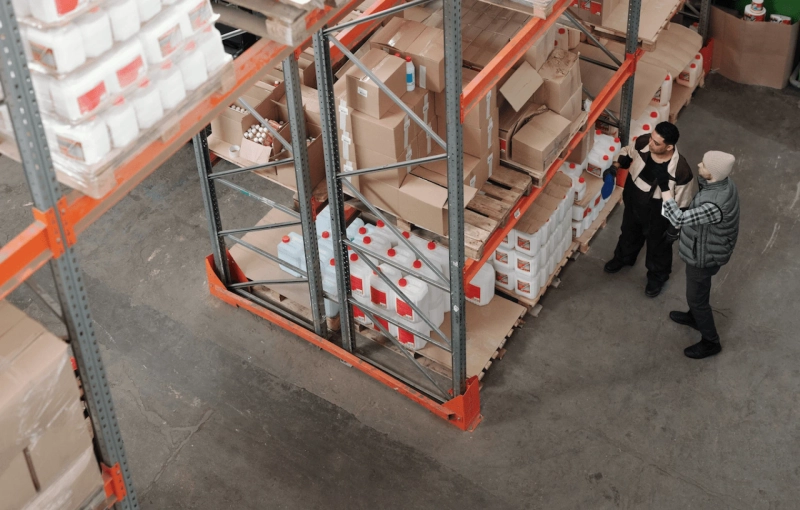In an increasingly competitive global economy, efficient warehouse design is no longer a luxury but an essential prerequisite for successful operations.
rThis article will outline ten crucial considerations to guide the design process of a warehouse, ensuring that the final layout not only meets current requirements but can also adapt to future needs.r
1. Warehouse Space Utilisation
rThe foundation of warehouse design is the efficient use of available space. This isn't just about maximizing storage; it's about creating a workflow that ensures goods are easy to find, retrieve, and deliver. Proper space utilization can also reduce handling costs, errors, and damages.rrConsider the physical dimensions of your goods to determine the type and configuration of storage units needed. Remember to account for receiving and dispatch areas, offices, and other non-storage spaces. Also, consider vertical space and whether you can safely stack goods or install taller storage units.r
2. Material Handling Equipment
rMaterial handling equipment (MHE) is critical to warehouse operations. Selecting the right MHE depends on the nature of the goods, storage systems, and order picking methods. Ensure your warehouse design accommodates the required MHE, leaving enough space for safe manoeuvrability. Consider automation where possible to enhance speed and accuracy while reducing labour costs.r
3. Workflow and Process Design
rEffective workflow design minimises unnecessary movements and streamlines the picking, packing, and shipping processes. Each warehouse operation, from receiving to dispatch, should flow smoothly into the next, with minimal backtracking or congestion.rrUnderstand your processes thoroughly before starting the design. Simulate different scenarios to identify potential bottlenecks. Use this information to arrange your warehouse in a way that supports your workflows, such as by grouping frequently co-picked items or by placing high-turnover goods closer to dispatch areas.r
4. Enhancing Product Quality and Safety
rIn warehouse design, integrating specialised equipment can significantly enhance product quality, safety, and operational efficiency. For example, a specific subset of warehouses necessitates the application of coatings or paints as a part of their processes. Although not directly visible in every warehouse, the principles learned from the effectiveness of such specialized applications can benefit many operational setups.rrOne such specialized setup is the use of industrial tools that provide controlled environments for specific tasks, thereby reducing errors and enhancing the quality of the final product. These tools can range from
spray booths for painting to precision temperature control systems for warehouses dealing with perishable goods. Incorporating such specialised equipment into warehouse design is an essential consideration to improve overall operations.r
5. Flexibility and Scalability
rWhile your warehouse design should cater to current needs, it must also anticipate future growth and changes. Business needs can change rapidly, and the warehouse should be able to adapt without requiring substantial redesign.rrModular storage systems, for example, can be reconfigured easily to accommodate different goods or volumes. Also, consider how technology might change your operations in the future and how this might influence your design. Leave room for possible expansion or technological upgrades.r
6. Safety and Compliance
rA well-designed warehouse prioritises the safety of its workers. This means designing clear walkways, adequate lighting, and safe workspaces. Ensure your design complies with local regulations and industry standards, such as those relating to fire safety or hazardous goods storage.rrInvest in safety features like guardrails, safety signage, and emergency exits. Also, design your warehouse to minimise the need for manual lifting or high-reach work, which are common causes of workplace injuries.r
7. Technology Integration
rTechnology is revolutionising warehouse operations. From warehouse management systems (WMS) to automation and robotics, technology can dramatically improve efficiency and accuracy.rrConsider how technology will integrate with your warehouse design. This might involve infrastructure for charging stations, space for automated guided vehicles (AGVs), or the layout of barcode scanners. Also, ensure that your WMS can integrate with other systems, such as your enterprise resource planning (ERP) system, to streamline operations further.r
8. Ensuring Robust Infrastructure
rThe infrastructure of a warehouse is akin to the backbone of the human body. It supports all the functions and operations within the space, from lighting and temperature control to the powering of essential equipment. A crucial aspect of this infrastructure is the electrical system, which, if not designed and maintained properly, can lead to inefficiencies and, in the worst-case scenario, halt operations. Working with an
electrician you can trust is essential for getting the most out of your warehouse.rrWorking with professionals who specialize in delivering comprehensive solutions in this space can make a significant difference. For instance, partnering with a reliable service provider can ensure that your warehouse's infrastructure is not only designed to meet the current needs but also scalable to adapt to future demands. This approach helps in maintaining a robust infrastructure that not only keeps operations running smoothly but also mitigates the risk of costly downtime.r
9. Environmental Sustainability
rMore than ever, businesses are being held accountable for their environmental impact. Sustainable warehouse design can not only reduce your ecological footprint but can also lead to cost savings in the long run.rrConsider incorporating green technologies, like solar panels or energy-efficient lighting. Use insulation and smart design to regulate warehouse temperature and reduce HVAC costs. Also, consider your water use and whether you can incorporate rainwater harvesting or water-efficient fixtures.r
10. Cost Efficiency
rLast but not least, your warehouse design should be cost-efficient. While it's crucial to invest in quality infrastructure and systems, you need to balance this with your budget and return on investment expectations.rrCalculate the total cost of ownership (TCO) for different design options, factoring in not only initial capital costs but also ongoing costs like maintenance, energy, and labor. Also, consider how design choices might impact other costs. For example, a more efficient layout might reduce handling costs, while automation could lower labor costs.rrIncorporate energy-efficient technologies and practices that can result in significant savings in utility costs. Opt for durable, low-maintenance materials and equipment to reduce upkeep costs.rrRemember, the cheapest option isn't always the most cost-efficient in the long run. Investing in quality can pay off by reducing breakdowns, errors, and inefficiencies that can disrupt operations and harm your bottom line.r
Conclusion
rPlanning a warehouse is a complex task that requires careful consideration of many factors. These eight considerations - space utilization, material handling equipment, workflow design, flexibility, safety, technology, sustainability, and cost efficiency - provide a solid foundation for your design process.rrEvery warehouse is unique, and there's no one-size-fits-all design. The best design for your warehouse will depend on your specific operations, goods, and business goals. But by considering these factors, you can create a warehouse that is not only efficient and effective today but also ready to adapt to whatever the future brings.rrRemember, warehouse design is not a set-and-forget task. Regularly review your design and operations to identify potential improvements. As your business evolves, so too should your warehouse. With careful planning and ongoing management, your warehouse can be a powerful asset that drives your business success.


